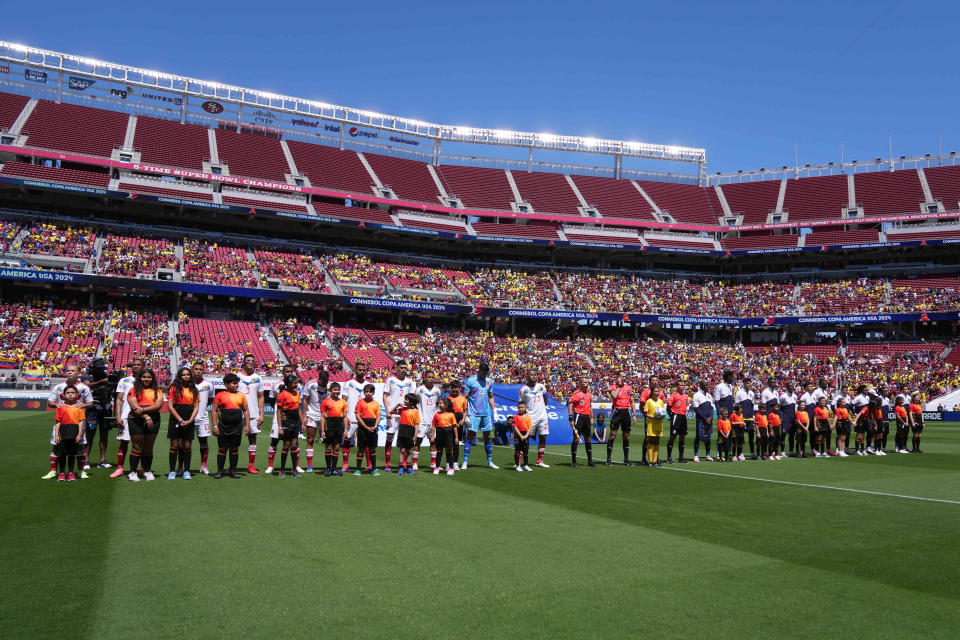Another reason that Copa América venues haven’t filled is that simply getting to them can be expensive.
Even for locals, many NFL stadiums are inaccessible via public transportation — unlike most European soccer grounds. So you have to pay to park. You’ll probably spend obscene amounts on drinks or food. The costs add up.
They’re especially prohibitive, though, for Copa América’s core audience: soccer fans in South America.
All but one Euro 2024 participant is less than 1,000 miles from Germany. In fact, eight of 23 share borders with the host nation. Every South American country, on the other hand, is more than 1,000 miles from every mainland U.S. city. Most are 2,000 miles away from Copa América host cities. Whereas Hungarians can get to Germany for $30, an Argentine eyeing New York would typically have to spend over $1,000 on round-trip airfare.
Oh, and $1,000 to a middle-class Argentine is a lot more than it is to a middle-class American (or Brit, or Dane). The strength of the dollar and the U.S. economy, compared to struggling South American economies, often makes summer vacationing in the States unfeasible. (Obtaining a B2 visitor visa can also be exceedingly difficult, and require a months- or even years-long wait.)
Still, thousands of South Americans have traveled for the 2024 Copa América. Juan Emilio Roa, CONMEBOL’s commercial chief, told Yahoo Sports prior to the tournament that around 25% of match-going fans would be foreigners. Travel agencies offered all-inclusive packages, including tickets that were exempt from the dynamic pricing scheme.
The distance and cost of travel, though — to the U.S. and within it, between the 14 host cities — surely kept many more thousands of fans at home.
Different teams, different countries, different crowds
The 2024 Copa América’s target in-stadium audience, then, has been an American audience — and especially the diverse and vibrant Latino communities scattered across the U.S.
Latin American diasporas, though, aren’t evenly distributed. There are over 37 million Mexican Americans. There are over 1 million Colombian Americans. But there are fewer than 100,000 Uruguayans and Paraguayans here in the States, according to Census data.

Venezuela and Ecuador players stand on the pitch before the game at Levi’s Stadium. (Darren Yamashita-USA TODAY Sports)
Their national soccer teams also enjoy varying levels of popularity. Demand for tickets, therefore, has varied from game to game. Colombia drew 67,059 in Houston on Monday. Brazil-Costa Rica drew a similar number Monday with 67,158 in attendance at SoFi Stadium in greater Los Angeles. Argentina sold out Mercedes-Benz Stadium in Atlanta. But when Venezuela and Ecuador met in Santa Clara, California, the Levi’s Stadium stands were mostly barren. Ditto for Uruguay and Panama in Miami.
The most curious attendance figure was the 53,763 for Mexico vs. Jamaica, some 18,000 shy of the capacity at NRG Stadium in Houston. It was likely a function of ticket prices, El Tri’s downswing and fatigue.
Market fatigue?
In the buildup to this Copa América, several industry sources speculated to Yahoo Sports that organizers were struggling to distinguish this tournament from the rest of a crowded soccer market. Most participating teams regularly play friendlies in the U.S. The six CONCACAF squads have played Gold Cups and Nations League finals. The U.S. and Mexico played a final at AT&T Stadium in Arlington, Texas, just three months before the U.S. opened Copa América there against Bolivia.
​​”It is a little bit strange coming back to the same places,” U.S. midfielder Tyler Adams admitted Sunday.
And even to him, as a player who understands the prestige and significance of Copa AmĂ©rica, “it doesn’t feel quite different [from a Nations League finals] yet,” Adams said.
If it doesn’t feel different to him, does a casual fan understand that it is in fact more significant?
Adams added, though: “Our fans showed out today.” There were 47,873 in the 80,000-seat stadium, many wearing red, white and blue. “And I was happy with that,” he said. He hopes, though, that “we’re gonna have some big games ahead of us,” and those will feel more distinct, with even bigger audiences.
Source link : https://sports.yahoo.com/why-do-copa-america-games-have-empty-seats-its-about-more-than-ticket-prices-151017048.html
Author :
Publish date : 2024-06-25 11:27:13
Copyright for syndicated content belongs to the linked Source.












